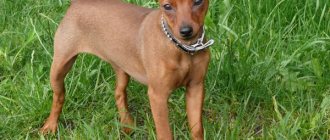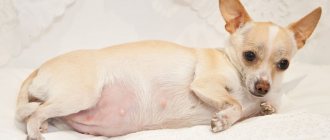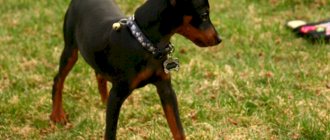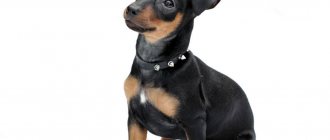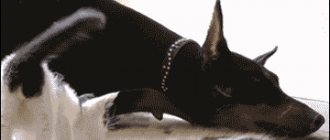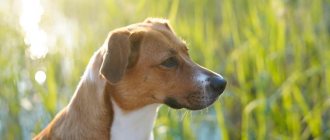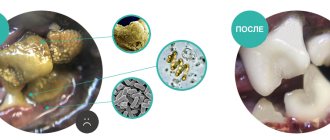Proper feeding is the key to a dog’s good health, regardless of its breed, size and gender. However, preparing a diet for small ornamental breeds requires special care. Pinscher food should be nutritious enough to provide energy to an active dog, but not too high in calories as to cause obesity.
The puppy refuses to eat: what to do?
Puppies may lose their appetite due to teeth changes or errors in nutrition, as a result of which the functioning of the gastrointestinal tract is disrupted. Although sometimes they try to manipulate their owners by refusing food, luring out tastier pieces or attention to their person. If the dog does not eat for more than a day, it is still better to consult a veterinarian.
A new pet is not only a sea of positivity and a surge of emotions, but also responsibility. By becoming a dog parent, you undertake to care for your four-legged dog “through thick and thin.” As the experience of veterinarians and breeders shows, most of the tragic consequences have very prosaic reasons - oversight, poor nutrition, lack of daily routine and walks. When it comes to small breeds, the situation gets worse; pets are perceived as toys, pampered, and thus “brought” to the veterinarian’s table. Nutrition is quite an important issue, if only because the breed is prone to obesity and urolithiasis, and these are direct consequences of “flaws” in the diet.
Feeding, regimen, preferred foods - all these factors are individual and depend on the dog itself and the capabilities of its owner. The most pressing question will not be what to feed, but how to feed it correctly. The dog is quite specific, small, but active and omnivorous. So, let's look at the main points:
- The regime and diet of the Miniature Pinscher
are “stable” concepts, that is, they should not change too often. If you decide that you are feeding your pet natural food, then ready-made dry food is completely excluded.
- Feeding times should be as fixed as possible.
This will make it possible to predict the walking period and avoid troubles in the form of a meadow of heaps.
- The adaptation period
is a period of 10 to 14 days after purchasing the puppy. The baby needs to be provided with conditions as close as possible to his previous home. You may be able to take some of the litter with a familiar smell. The diet, daily routine and walks also remain unchanged.
- The frequency of feeding and daily food intake depend on age
- when feeding “natural”, portions are calculated based on the weight of the puppy. Ready-made industrial feed is fed according to the instructions, which are on each pack.
- If you want to change your diet, take it gradually!
They begin to add ready-made wet food to drying, and then replace it with meat. The reverse algorithm is the same. The transition period should not be more than 14 days.
The Miniature Pinscher (Miniature Pinscher) is a small dog, but what it has in common with its decorative relatives is only its compact size. This is a pet with strong nerves, a strong character and irrepressible energy. All this must be taken into account when choosing the appropriate diet for your little pet. What should you feed your miniature pinscher to keep him in good physical shape and active and positive?
A puppy in the house is a sea of positive emotions, joy and delight. But owners should not forget about responsibility. The dog needs care, walks, and quality food. Unfortunately, veterinarians and experienced breeders note that not all owners approach this issue with due attention, and four-legged babies often suffer from neglect, poor nutrition, and lack of regular walks and routine.
As for representatives of small breeds, the situation is aggravated by the fact that dogs are perceived as toys, are constantly fed from the table and pampered with various delicacies. If you do this constantly, then soon the pet will end up on a hospital bed... Miniature pinschers have a tendency to obesity and urolithiasis, but most often the signs of these pathologies appear as a result of flaws in feeding.
Raising a miniature pinscher puppy at 2 months
At 2 months old, your miniature pinscher puppy is still at home, in quarantine after the first vaccinations, and he is not yet allowed to go for walks. Therefore, it’s time to start raising a puppy in familiar home conditions.
The first step is to teach the puppy to go to the toilet in a diaper. At the same time, it should be remembered that any learning is a rather complex thing, and when you see the first positive results, you should not think that your puppy has already understood everything, but you should continue training according to the method, so that after a while you do not have to start all over again.
The second important point will be to accustom the puppy to a collar and leash. Yes, yes, this should be done at home, so that by the time the puppy goes outside for the first time, wearing a collar will not be additional stress for him, but is already a familiar thing, and he can begin to explore the world around him, rather than trying get rid of an unknown object.
The third point, which causes the greatest difficulties for new puppy owners, will be determining the boundaries of what is permitted for the puppy:
- Teach to play only with your toys, and not with your things;
- Explain that you cannot bite your hands even in a game;
- Establish the correct daily routine, establishing the rule that in the morning you need to sleep and not wake you up;
- Stop chewing furniture, clothes, walls and baseboards;
- Teach to stay home alone, knowing that your absence is not a reason to bark or howl.
IT IS EXTREMELY IMPORTANT TO KNOW: that constant and excessive punishment following almost every action of the puppy has a detrimental effect on its fragile psyche and can lead to the fact that the miniature pinscher puppy grows up cowardly and embittered. For normal natural development, a puppy must have the opportunity to explore the world around him, which is currently limited to your apartment or house.
You should also begin now to familiarize yourself with the initial obedience commands in a light playful form, while focusing on rewards for execution, because the puppy’s psyche is still quite plastic and excessive severity and exactingness can lead to the puppy being intimidated and cowardly. Therefore, it is necessary, first of all, to try to interest the puppy by offering him a toy or treat, and sometimes just praise.
Features of feeding a miniature pinscher
Although every dog is different, there are a number of common aspects to feeding each breed. It is important not only to choose the right food, but also to adhere to the regime. The main principle of nutrition for the miniature pinscher is stability:
- Having chosen one or another type of feeding, the owner should focus on it - a mixed diet is not suitable for miniature pinschers, and frequent switches from industrial food to natural food and back can negatively affect the health of the pet.
- It is important to adhere to the regime - it is advisable that the pet receives food at approximately the same time; This is not only useful for the functioning of the dog’s gastrointestinal tract, but will also help to quickly accustom the dog to the street - he will relieve himself on time, and you can forget about puddles and piles.
- When taking a puppy to a new home, it is preferable to feed it in the first 10-14 days with the same food that it received in its previous family - this will speed up the adaptation process, and the baby will quickly get used to the new conditions.
- Walking your pet should be done at least half an hour after feeding - it is undesirable for your pet to be active with a full stomach, as this can lead to gastric volvulus.
- Regardless of the type of feeding, all food left behind should be removed - the bowl should remain empty between meals.
- Water – the dog should have round-the-clock access to water, and it should be changed to fresh in the morning.
Miniature Pinschers are not very picky eaters, but the wrong approach of the owner can change this situation. When a dog has a bowl full of food around the clock, and every now and then table scraps or other “goodies” end up in it, he becomes more selective and, accordingly, capricious.
Normally, meals should take place according to a schedule, last no more than 15 minutes, and after the meal the leftovers should be removed - then the dog will be interested in food, and there will be little to distract him from the process of absorbing food.
Socialization of a miniature pinscher puppy at 3 months
Three months is an important stage in a miniature pinscher puppy’s introduction to the outside world. Your first walks should be short and not too tiring for the puppy.
At this age, the puppy’s nervous system is forming, so it is necessary to show him as much as possible: noisy streets, large crowds of people, etc. This must be done very carefully, gradually, over and over again increasing the time spent in noisy places, so as not to overload the puppy and scare him.
It is also necessary to introduce the puppy to friendly dogs and people, so that later the puppy does not develop aggression or cowardice caused by the fear of new things and the inability to communicate and make new acquaintances. And this is currently, unfortunately, not uncommon in the behavior of adult dogs, but a fairly common problem with which people turn to our specialists for help.
The emergence of new places leads to new rules that need to be consolidated:
- Now you can and should go to the toilet on the street, rather than steadfastly endure and carry everything home;
- Not every new person or dog wants to communicate, so you don’t need to run headlong to meet everyone;
- Not all food is healthy, so it should only be taken from the owner’s hands.
Training a puppy follows the same principles as at 2 months. It should be remembered that at this age puppies develop conditioned reflexes quite easily, but they are also quickly forgotten, so you should not scold the puppy for not following commands, especially if they have not been repeated for a long time, but you should pay more attention to learning new things and repeating already learned material .
What type of feeding is best for miniature pinschers?
The owners of this active baby have a choice - everything is suitable for pinschers, except a mixed type of food.
Dry diets
The simplest option for the owner, which does not require cooking or creating a menu yourself - the manufacturers have already included everything necessary in it and in the right proportions. However, this only applies to premium or super-premium products that are made from high-quality healthy raw materials. Another point - dry granules already contain vitamins and microelements, so the pet will not need additional feeding.
You should not feed your dog low-quality food that is sold in regular supermarkets or food markets. Typically, the main ingredients of such “drying” are not meat components, but grains, which dogs can eat, but in small quantities. In the first place in the composition there should be meat, fish, offal - the miniature pinscher, although small, is still a dog, in fact, a predator.
It is recommended to purchase food at a pet store or veterinary pharmacy. The packaging must be tightly sealed, production and storage times are indicated on the label and strictly observed. You should not buy granules by weight - there is a risk of getting a low-quality, spoiled or expired product.
When choosing a suitable brand of food, you should focus on the size, coat type, and age of the pet. You should not feed an adult dog puppy kibble, and vice versa. If your pet has health problems, you should consult a veterinarian. He may recommend giving your dog a therapeutic diet or holistic food.
If the owner does not want to take risks when choosing a “drying”, because sometimes it will be necessary to go through several options, then you can find out from the breeder what brand of diet he feeds his charges and settle on it.
Wet and canned food
The manufacturer offers various products, and in the premium and super-premium segment they meet the high requirements of veterinarians and experienced breeders. But if you feed your pet only canned food, then even in the case of a small pinscher, the food will be quite expensive - such diets are less concentrated, and the dog will need quite a lot of food for one meal.
You can feed your pet such food periodically, as a treat or reward. It is also useful to give wet food during the recovery period of your pet - after surgery or illness. Experts recommend choosing canned food of the same brand as the main dry food.
Natural products
“Natural” has both advantages and disadvantages. The first include the opportunity to create a varied menu for your four-legged friend, in some cases save money, treat him with healthy treats - crackers, pieces of vegetables, fruits, nuts. In addition, if you include only healthy foods in your diet, the food will be well absorbed.
But there are also certain disadvantages, which include the following:
- It is quite difficult to create a balanced diet on your own so that your pet receives all the important components in the right quantities;
- You will have to prepare food every day, which requires a significant investment of time and effort;
- the dog will have to be given additional supplements and vitamin-mineral complexes;
- Determining the serving size is more difficult than in the case of ready-made food - it is important that the dog does not starve or overeat.
When choosing the appropriate type of feeding, the owner should pay attention to the pet’s preferences - often by its behavior and well-being it can be understood that the food is beneficial.
What to feed your miniature pinscher: dry or natural diet
The diet of an adult dog must contain the necessary set of vitamins and minerals, the proportion of meat is reduced, and fish, cottage cheese, eggs, and greens are actively introduced into the food. The dog's preferences are well understood by the owners, and, as practice shows, the pinscher is more likely to teach the owners what and how to cook.
The diet of an adult miniature pinscher includes meat, fish, and vegetables.
You need to make sure that your diet is simply balanced: vegetables, fish, and cereals are a must. Many dogs do not digest dairy products well, but kefir or fermented baked milk should still be poured into the bowl periodically.
A hard, raw green apple will perfectly cleanse the teeth, carrots or beets will cleanse the intestines, so it is better for the owner to insist on his own and force the pinscher to eat vegetables or fruits, rather than gnawing on a beef bone all day, which is more suitable for playing.
When choosing the type of food for your dog, there are many nuances to consider. Much depends on the financial situation of the owners and their preferences.
Natural food from vegetables, cereals and other products takes time to prepare, but it is certainly fresh and requires less financial outlay. However, you will need to additionally purchase vitamin and mineral complexes so that the dog grows and develops normally, receiving everything it needs.
Dogs eat wet canned food very willingly; the norms and age categories are clearly written on each package, so it is impossible to make mistakes with the calculations of portions, calories, vitamins and minerals. They are convenient to store in refrigerators, buy for future use, and divide into portions. Such food is produced for dogs from 1 month of life, so there is no need to buy fresh milk every day or prepare porridge.
Dry food is the most convenient from the owner’s point of view; pinschers themselves adore it. They can be stored for a long time, are convenient for travel, and contain everything necessary for energetic kids and adult pets. It will take some time to accustom the puppy to them, soaking them in milk or warm water in the first weeks of complementary feeding.
When starting to feed your dog according to one type, you should not mix canned food with natural food or dry food, or transfer from one type to another, so as not to spoil the dog’s stomach or intestines.
Feeding your miniature pinscher with natural products
The natural type of feeding is closest to natural nutrition, but requires time for cooking every day, since the maximum storage time for food is 24 hours.
The photo shows prepared natural food for a miniature pinscher.
For 100 g of dry porridge you need 40-60 g of meat (fish), 100 g of steamed or raw vegetables, 1 egg 2 times a week, 100 g of cottage cheese (kefir, fermented baked milk) 1 - 2 times a week. Bones (beef or large pork, so that the dog cannot chew into small, life-threatening fragments for the little brave man) can also be given no more than once a week.
Feeding your Miniature Pinscher dry food
When deciding what to feed your miniature pinscher, many people choose dry food. “Drying” is good for many things: it is convenient to store and use, it contains everything necessary for a balanced diet. I just poured it into a cup and the animal contentedly gobbled up everything down to the crumbs.
You should not believe everything that is written on the packaging. And even if a product is positioned as consisting of natural meat, it contains all the microelements, this does not mean that this is true.
Here are the main criteria that you should rely on when choosing food:
- Good food is perfectly digestible, that is, the pinscher will not be bothered by gases, he will eat well and will last until the next feeding, and there will be a minimum of discharge during bowel movements.
- You should not buy food from manufacturers who produce food for people, this can only mean that all the production waste that belongs in a landfill, after being processed, has become food for dogs. Well, if there is simply no benefit, such products often cause harm to pets.
- Not promoted, but professional food (veterinarians will tell you about them) is necessary for the dog. This food is not cheap, but it allows you to save on visits to veterinarians.
Choosing dry food for your miniature pinscher is a crucial step.
High-quality food can be found in pet stores (not all), or rather, in stores specializing in food. There are specialists here who will select food that is ideal for the dog, depending on its age and individual characteristics.
Dry food comparison
Read, read and read again what is written on the packages. Soy, corn flour and other poorly digestible ingredients, especially dyes and flavor enhancers, are contraindicated for dogs of toy breeds.
Food with an unclear composition: poultry, offal, soy flour - all this means only one thing - there is no real meat, no nutrients, only low-quality protein filler.
You can buy a lot of cheap food and calm down for a long time, believing that the dog is getting everything it needs. But basically they are made from corn or soy flour, legumes, instead of meat and offal, introducing chopped chicken paws, feathers, skins, using those obtained from dead or sick animals as a fat filler.
Only a few manufacturers include real and healthy meat and fish products that dogs need so much. They are much more expensive, but they have a truly balanced composition.
Purina food contains, for example, corn flour, offal, and beef fat, which means it is unlikely to contain meat. But Timberwolf Organics, a lesser-known product, but much more expensive, includes elk meat, salmon, potatoes, as well as oats, spinach and many other ingredients, all clearly and clearly stated.
There are several classes of dry dog food: economy, premium, superpremium, holistic.
Science Diet, the first to include grain, does not hide the fact that the fee is taken mainly for a cheap filler, which gives only a short-term feeling of fullness. It's hardly worth paying for such a product.
Dry food is divided into classes:
- Economy class on the packaging means extremely low quality; such foods do not contain any vitamins or minerals (such products include Oscar, Trapeza, Chappi, Darling foods).
- Premium - a significantly higher content of animal proteins plus a truly balanced vitamin complex (Chicopee, Araton, etc.).
- Super-premium - the inscription means that the composition contains natural meat, fats, eggs, and healthy additives with which there is no need to fear for the dog’s health (Forza-10, Guabi Natural, Porcelan).
It is the quality of the product that determines its price, so you should not harm your pet with economy-class food. If your financial capabilities do not allow you to purchase dry food of the “holistic” class, it is better to choose those that are a step lower, but balanced in composition and made from high-quality raw materials.
Many dog breeders consider the following foods ideal for miniature pinschers:
- ProNature Holistic is a super premium food from Canada.
- American premium food Hills.
The Czech Brit Premium, the Swedish Bozita, the Russian-French Royal Canin of high quality, and the American Diamond, also of high quality, are perfect for pinschers.
Many miniature pinscher owners feed their pets Hills dry food.
It is worth paying attention to the American Nutra Gold (super-premium) and the Italian Almo Nature of the same class.
Transfer from one type of feeding to another
If the owner decides to feed the Pinscher other food, then it is important not to rush and pay due attention to adaptation: when, instead of the usual food, the dog begins to receive a completely different product, this will turn out to be extremely stressful for its body. The pet may have problems with digestion, stool, vomiting, bloating and other problems with the gastrointestinal tract.
When it is necessary to introduce a dry diet, it is included in the menu gradually, first replacing part of the portion, and then completely. When changing the drying brand, you should proceed in exactly the same way.
When switching your pet from a commercial diet to a “natural” diet, you can gradually feed the dog canned food without removing the granules. Then add pieces of meat and other products to it. And then offer the dog ready-made meals made from natural food. On average, the entire translation process can take from 7 to 14 days.
Training a miniature pinscher puppy from 6 months
At this age, the puppy begins puberty and the real rebel awakens in him. He begins to re-test the boundaries of what is permitted and, sometimes, deliberately does not respond to your commands, only in order to look at your reaction. If she is not what the puppy expects to see, then he may decide that now he can no longer carry out your commands.
It should be remembered that the puppy is still a child, and excessive harshness can forever undermine his trust in you.
At this stage of the miniature pinscher puppy's growing up in training, all the shortcomings made at the previous stages, which were smoothed out by his young age, become clearly visible. And if they appear, then it’s time to correct them.
In many training schools, there is an opinion that a puppy needs to be trained in two stages, the first at an early age, and the second at 8 - 10 months, in order to “consolidate” what has been learned. This is not an entirely correct position; this opinion appeared when newer operant training methods began to be added to the old “DOSAAF” rigid training methods, where they began to work with the puppy strictly after 6-7 months, including working with the method of pointing and following the “target”.
Their weakness was that these were two different methods that began to be used without adaptation to each other, having a huge gap between their tools for developing training skills. The difference between them is like between choreography lessons in kindergarten and army drill training. Therefore, they required training in two stages, which were in no way connected with each other.
Modern methods based on animal psychology make it possible to train a puppy in a single system, when no additional stages of training are required.
Foods suitable for feeding your miniature pinscher
The owner who has chosen the option of natural feeding should know what products his dog can eat. This list includes the following:
- Meat
- it is given raw (1/3 of the total) and boiled (2/3 of the total). If the dog refuses the raw product, you can first scald the pieces with boiling water. Lean beef and veal are most suitable, but it is better to avoid pork. - Cereals (buckwheat, rice, oatmeal)
- the dish should be given to puppies well-cooked, but for an adult dog the porridge can be cooked less or even filled with broth and left to swell until it swells, as the product will retain more nutrients. - Fish
- preferably it should be sea fish, lean fish, slightly boiled and cleaned of bones; it is given 2-3 times a week, replacing one serving of meat. - Vegetables
- boiled carrots, beets, cabbage, zucchini, pumpkin - must be present on the menu of your four-legged friend. They are cut into cubes or grated. To make food better digestible, it is seasoned with a small amount of cream or butter. It is also useful to treat your pet with pieces of raw vegetables. - Crackers
- preference should be given to rye ones, they are better digestible, and chewing them is an excellent prevention of plaque and tartar. - Eggs
- they are included in the menu, but no more than 2 chicken or 4 quail per week. At the same time, they are pre-boiled, and if the pet refuses to eat, you can chop the eggs and add them to the main dish. - Fruits and dried fruits
are an excellent treat for a miniature pinscher. Few dogs will refuse a piece of prunes, dried apricots, raisins, a slice of pear, kiwi, melon, watermelon, or 2-3 currants, or 1 strawberry.
The owner should not think that the dog needs a varied diet. In fact, what matters more is the balance of the ingredients and their usefulness. The fact that the dog is eating properly is indicated by its shiny coat, activity and cheerful disposition.
The miniature pinscher (miniature pinscher) is a breed of small dog with an energetic character and elegant appearance. The dog's height does not exceed 30 cm, and its weight is 5 kg. He has a slender body, an elongated muzzle, and coarse short hair. Despite its small size, the pet fearlessly guards its owners and takes a leadership position among other pets.
Characteristic diseases
Due to their short fur, miniature pinschers often freeze in winter and overheat in summer. Therefore, the dog’s diet should be designed in such a way as to strengthen the immune system and prevent colds. In hot weather, you should avoid direct sunlight and carry water with you to drink.
Colds can be complicated by more dangerous pathologies. Thus, miniature pinschers are often diagnosed with urolithiasis. It is caused by hypothermia of the body from lying on the cold ground.
Another significant reason is an incorrectly composed diet, in which there are too many meat products.
This breed of dog has weak tracheal cartilage. Inhalation of cigarette smoke, dust, allergens, and cold air often leads to organ collapse. And thin bones and joints are responsible for the occurrence of polytrauma. After a fall while walking, miniature pinschers are always taken to the veterinarian, even if there is no lameness. To strengthen the skeleton, it is necessary to regularly give your dog vitamin and mineral supplements.
Feeding rules
Miniature Pinschers value consistency and do not like change. When moving from a breeder, they must be fed the same foods during the first week. Next, you should choose a diet and strictly adhere to it. In an adult dog, meals, walks, and hygiene procedures are carried out at the same time.
The Miniature Pinscher should be fed in small portions. Dry food is measured according to the instructions on the package. Natural nutrition is calculated using the formula 25 grams per 1 kg of live weight. The filled bowl is placed in front of the dog, and after 15 minutes it is removed and washed. Thanks to this regime, the dog is not distracted, does not play with food, and does not expect tastier pieces.
Basic diet rules
From the first days a miniature pinscher appears in your home, you need to treat its diet with care and attention, remember how much to feed and what to feed.
The Miniature Pinscher is a service dog, albeit a small one, and it needs the right diet.
The main parameters here include:
- adaptation - after weaning the puppy from its mother, you need to carefully listen to the breeders’ advice about feeding, the foods that were used to start complementary feeding, so that during the first 10 - 14 days you feed as similar as possible;
- consistency - it is necessary to strictly adhere to the type of food that is chosen for the puppy: natural products, canned food or dry food;
- caution - introduce any new product in small portions, without changing the main diet.
The food must contain:
- meat - at least a third of the rest of the products, it is better to give beef raw, poultry is acceptable for the baby;
- plant food - from ¼ to 1/3 depending on the individual preferences of the pinscher; they happily eat carrots, beets, cabbage both raw and stewed with a small addition of vegetable oils;
- cereals - oatmeal, buckwheat and other cereals should also make up at least 1/3 of the diet;
- fish is a product that should be given at least 2 times a week instead of meat, carefully removing the bones.
Important. One of the main rules is the portion size: the dog must eat it at once, and there should be no food left in the bowl. You can calculate the approximate portion according to the principle: for 1 kg of weight - 25 g of food at one time.
The diet will help the pinscher quickly learn that food appears at the same time, and after 10 - 15 minutes it is no longer there, that is, the baby will not be distracted, play, turn up his nose in disgust, waiting for something tastier. This will make caring for your pet much easier.
The miniature pinscher's bowl is placed for 15 minutes, after which it is taken away until the next feeding.
The Pinscher is a working dog, and the word dwarf refers to the portion size, not the food, this must be remembered when deciding how to feed the Pinscher with his simply irrepressible energy and thirst for activity.
Eating natural products
The advantage of natural food is the confidence that the dog is eating high quality foods. The owner prepares the diet himself and monitors the freshness of his dishes. He knows that the food contains no flavor enhancers, spices, dyes, or prohibited ingredients:
- fatty meat;
- raw fish;
- legumes;
- bones;
- sweets.
The diet of a miniature pinscher, based on natural food, should include protein products. Moreover, for puppies the share of meat is 60%, and for adult dogs – 40%.
Dogs of this breed have a strong jaw and strong teeth. Therefore, it is better to give them raw veal, beef, and horse meat. To destroy helminths, the pulp is frozen in the freezer, and to eliminate the smell of blood, it is scalded with boiling water.
A third of the diet should be porridge. They provide energy for development and play, and saturate them with microelements. The healthiest cereals include buckwheat, rice, and oatmeal. They are boiled in water and seasoned with vegetable oil or fish oil.
Another third of the total menu consists of vegetables and fruits. They contain not only vitamins, but also fiber, which improves intestinal motility. In addition, raw apples, zucchini, and carrots remove plaque and cleanse the interdental space.
An important part of the pinscher's natural diet is fermented milk products. Cottage cheese, fermented baked milk, and sour cream should be given regularly, but in small quantities. They are seasoned with porridges and mixed with vegetables and fruits. In addition, it is useful to feed dogs boiled eggs, nuts, and dried fruits.
For puppies
For the first two months, the puppies are fed by the mother. The breeder must provide the dog with high-quality, nutritious food. Many dry foods include granules made specifically for lactating bitches. If lactation has disappeared before 60 days, the owner uses cow's milk heated to 40°.
In the third month, the baby moves to a new home. Now the owner must feed the miniature pinscher puppy milk (5 times a day). He teaches the dog to eat from a bowl, gives him new foods: milk porridge, minced veal, an egg.
After trying each new product, you must monitor your pet for 12 hours to identify allergic reactions and individual intolerances.
During the change of milk teeth to molars (4-5 months), puppies need calcified food. Their daily diet should include milk, cottage cheese, fermented baked milk, fish, and nettle leaves. Moreover, you can ferment fermented milk products at home, with the addition of calcium chloride. Babies switch to four meals a day.
After six months, milk is completely removed from the menu due to lactose intolerance. At this time, the puppy already knows the taste of all foods. He can handle a piece of raw meat or chew boiled cartilage. This food develops the jaw muscles and strengthens the baby’s teeth. During this period, the miniature pinscher is given food 3 times a day. Moreover, dinner is given before bedtime so that he does not wake up from hunger.
Training a miniature pinscher puppy at 4 - 5 months
By this time, the miniature pinscher puppy has already become accustomed to your home and usual walking areas, and no longer needs your support and care so much. Therefore, he begins, flirting with other dogs, pretending that he does not hear you when you call him, and showing a certain persistence and disobedience when executing various commands.
This means it’s time to move on to full training. In classes at this age you can already be persistent and demanding. At the same time, the most important thing is not to overdo it, remember that classes should bring joy to both you and your dog, and only then will you be able to achieve the desired result.
What commands are practiced by a miniature pinscher puppy at 4 months:
- Calm movement next to the owner with and without a leash, with landing when stopping, with a change in pace and direction of movement
- Return to you upon request
- Staying in a free or certain position (sitting, lying, standing) for a long time: if necessary, wait for the owner on the street, when visiting a store or other establishment
- Indifferent attitude towards treats scattered on the ground
- Inhibitory command to stop unwanted actions
- Execution of a set of commands “sit”, “lie down”, “stand” at a distance and near the leg, when giving commands by voice and gestures
- Stop barking on demand.
For adults and older dogs
Adult and elderly miniature pinschers need to be fed 2 times a day. Already at 7-8 months you should switch to this diet and firmly adhere to it. On weekends, when the whole family gathers at the dinner table, many people want to feed the dog. Then you can use pieces of vegetables and fruits seasoned with vegetable oil.
Sample menu for an adult dog:
- 1st feeding – rice porridge with pieces of beef and carrots;
- 2 feeding – buckwheat porridge, seasoned with kefir and boiled offal.
Miniature pinschers live 12-14 years. In the ninth year of life, their diet gradually changes. The basis of the diet is now boiled veal and poultry. Porridges are mixed with vegetables and herbs to improve intestinal motility. The dog can be switched back to three meals a day. But at the same time, the daily energy value should be reduced, since walking activity is significantly reduced.
Our dog handlers
miniature pinscher training specialists
Alexander ChaplyginDog training instructor Zoopsychologist Experience: 35 years Ekaterina PanovaDog training instructor Zoopsychologist Experience: 32 years Lada YurtsevaDog training instructor Zoopsychologist Experience: 19 years Victoria FoxDog training instructor Zoopsychologist Experience: 12 years Yaroslav MorozovDog training instructor Zoopsychologist Experience: 2 3 years Ekaterina BudkinaDog training instructor Zoopsychologist Experience: 16 years Evgeniy BravinskyDog training instructor Zoopsychologist Experience: 15 years Vitalia BravinskayaDog training instructor Zoopsychologist Experience: 10 years Kira AgeevaDog training instructor Zoopsychologist Experience: 17 years Evgenia ZuberDog training instructor Zoopsychologist Experience: 11 years Vladimir TroyanovskyDog training instructor Zoopsychologist Experience: 5 years Anna TroyanovskayaDog training instructor Zoopsychologist Experience: 11 years Alexey MelikhovDog training instructor Experience: 20 years Sergey ShikerinDog training instructor Experience: 7 years
* Please check with the managers for the possibility of a specific specialist visiting your specified area . If the desired dog handler does not work in your area, then we can offer you another specialist from the above.
Industrial feed
Dry and wet food for miniature pinscher can be used from the age of two months. The lines of well-known companies include products for puppies. It is designed taking into account the growth of bones, teeth, high physical activity and is packaged in a portioned pack. Before feeding, gravies and pates must be heated to 40°C, and granules must be softened in milk or water.
The advantage of ready-made food is the ability to choose granules for dogs of different sizes, coat lengths, activity, and ages.
The developers also created products for pets with poor health: allergies, obesity, urolithiasis. However, the transition even to special nutrition should be carried out gradually, over 10-14 days.
Only the highest quality premium and super premium food is suitable for miniature pinscher. You can identify such products according to the instructions. The first component in the composition is always meat, and its share is 30-40%. Veterinarians recommend the following companies:
- Royal Canin;
- Hills;
- Mega Dog;
- Orijen;
- Pro Plan.
Recently, Holistic products made from environmentally friendly products (Innova, New, Acana) have been gaining popularity.
Combined feeding
Miniature Pinschers do not need a varied diet. It is much more important for them to receive balanced food. Therefore, when feeding dogs with high-quality food, you can avoid giving them fermented milk products, vegetables and fruits. But, if the owners decide to feed their pet natural food, they must follow the following rules:
- do not exceed the daily calorie intake of food;
- have different bowls for food, food, water;
- cook dishes without salt and spices;
- buy dry granules in small packs;
- Warm wet food to room temperature.
Rewards in the form of crackers, cheese, dried fruits, and cookies also have energy value. It must be taken into account when preparing your daily diet.
Reviews
Ivan, Khabarovsk
“I feed my miniature pinscher Pro Plan food. On the box for small breed dogs it is written how many grams per day you need to give your dog. I don’t feed Rocky anything else, as he is healthy and active.”
Snezhana, Tver
“When I bought a miniature pinscher, the breeders advised me to feed him Royal Canin food. Bonya eats little, so a pack lasts me a long time. Sometimes I share yogurt with my dog and he happily licks the bowl.”
